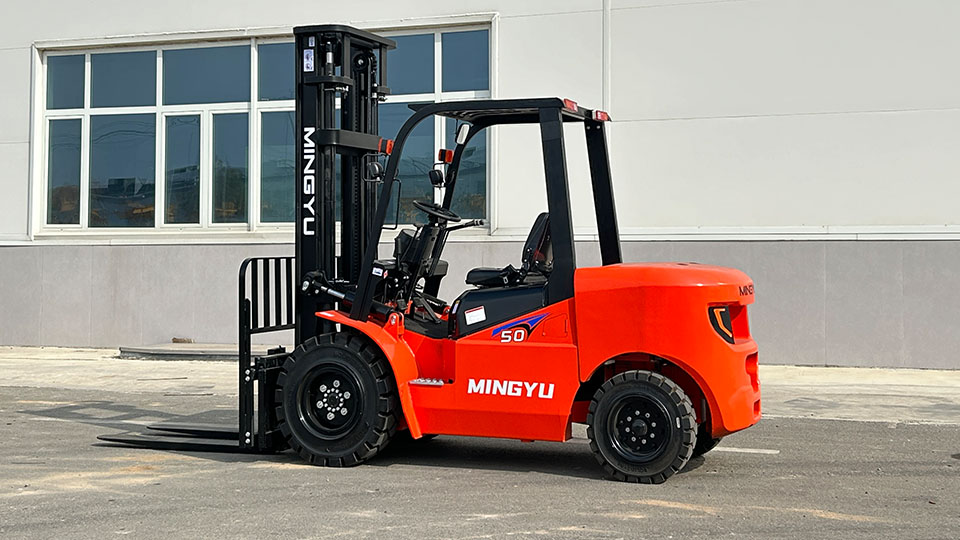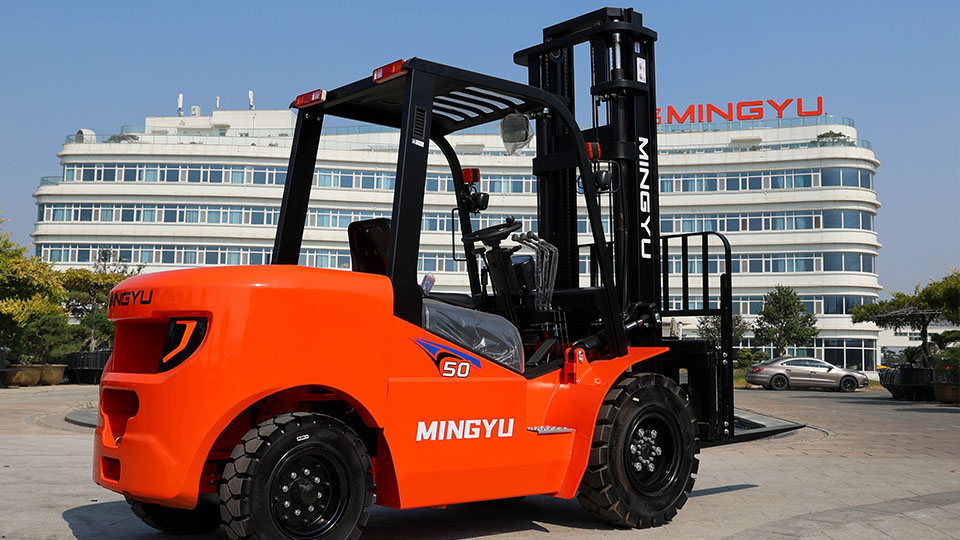
Executive Summary
Whether you are lifting 1-ton pallets in a temperature-controlled warehouse or 4-ton rebar bundles across a muddy construction pad, the choice of motive power—lead-acid battery, lithium-ion pack, hydrogen fuel cell, diesel, gasoline, or liquefied petroleum gas (LPG)—is the single most influential design variable that dictates acceleration, gradeability, hydraulic response, total cost of ownership (TCO), and even operator health.
Based on 2024–2025 field studies, OEM duty-cycle data, and ISO 23308-1 energy-consumption standards, the following hierarchy emerges:
Electric (Li-ion) dominates indoor, multi-shift operations where air quality and noise are regulated. Energy cost per pallet move is 65–75 % lower than diesel, but battery logistics can erase 4–6 % productivity if not engineered correctly.
Diesel remains the benchmark for raw torque, outdoor gradeability (>20 % laden), and rapid refueling. Modern Tier 4-F after-treatment adds 3–4 % fuel penalty and 12 % higher maintenance labor.

LPG/Gasoline offers a middle ground: 15 % lower particulate emissions than diesel, 60 dB(A) quieter, yet 20 % higher fuel cost per kWh delivered. Ideal for mixed indoor/outdoor fleets with 1–2 shift coverage.
Hydrogen fuel cells deliver “diesel-like” duty cycles (2–3 min refuel) with zero local emissions, but hydrogen logistics and capital cost still limit adoption to ≥50-unit fleets or 24/7 cold-storage sites.
Below, we dissect the engineering variables that create these deltas.
Energy Density & Specific Power
Battery Systems
• Lead-acid traction packs: 30–35 Wh kg⁻¹, 150–200 W kg⁻¹ peak. Adequate for 2,000 kg capacity forklifts operating ≤6 h single shift.
• Lithium iron phosphate (LFP): 110–130 Wh kg⁻¹, 600–800 W kg⁻¹ peak. Enables 7–8 h continuous lift, 2-shift operation with opportunity fast-charge at 1 C.
• Lithium nickel manganese cobalt (NMC): 150–180 Wh kg⁻¹, 1,000 W kg⁻¹ peak. Used in high-reach (>10 m) reach trucks demanding rapid mast traverse.
Fuel Systems
• Diesel: 36 MJ L⁻¹ (≈9,900 Wh L⁻¹) at 45 % engine efficiency ⇒ 4,455 Wh L⁻¹ delivered.
• LPG: 25 MJ L⁻¹ at 35 % efficiency ⇒ 2,430 Wh L⁻¹ delivered.
• Gasoline: 34 MJ L⁻¹ at 30 % efficiency ⇒ 2,830 Wh L⁻¹ delivered.
Implication: A 2.5 t diesel forklift with a 60 L tank carries 267 kWh of usable energy—equivalent to 2,400 kg of LFP battery—explaining why battery forklifts rarely exceed 8 t capacity without hydrogen.
Duty-Cycle Energy Efficiency (ISO 23308-1 VDI cycle)
Average kWh per pallet move (1.5 t, 4 m lift, 30 m travel):
• Electric Li-ion: 0.28 kWh
• LPG: 0.42 kWh
• Diesel: 0.55 kWh
The 2:1 ratio persists even after charger (92 % eff.) and engine after-treatment losses.
Torque Characteristics & Gradeability
Electric: 100 % torque at 0 rpm, ideal for ramp starts. A 48 V, 15 kW traction motor produces 300 Nm at wheel—sufficient for 15 % grade with 3 t load.
Diesel: Peak torque 450 Nm at 1,400 rpm. Turbo-lag + torque converter slip reduces instantaneous tractive effort; requires 2.3:1 axle ratio to match electric off-the-line performance.
Field test (Hyster H3.0FT vs Yale ERP030VT): 0–6 km h⁻¹ laden acceleration 3.8 s (diesel) vs 2.6 s (electric).
Hydraulic Response & Lift Speed
Pump flow Q = V × n_pump. Electric trucks use fixed-displacement gear pumps driven at constant motor speed—flow proportional to battery voltage sag. Li-ion maintains >90 % voltage throughout 80 % depth of discharge, yielding 10 % faster lift speed vs lead-acid whose voltage drops 15 % by 50 % DoD.
Diesel forklifts employ engine-driven variable-displacement piston pumps. Engine rpm modulation creates 20 % faster full-load lift speed (0.45 m s⁻¹ vs 0.37 m s⁻¹ electric), but only at >1,500 rpm.
Cold-Weather Performance
Battery internal resistance rises 40 % at −10 °C, reducing usable capacity 25 %. Integrated battery heaters (300 W) restore 90 % capacity, consuming 2.2 kWh per 8 h shift—cost-neutral vs fuel-operated coolant heaters in diesel at $0.14 kWh⁻¹.
Diesel suffers gelling below −18 °C; additive or winter-grade fuel adds $0.04 L⁻¹.
Refueling / Recharge Logistics
Electric
• Conventional 8 h charge + 8 h cool-down → single-shift.
• Opportunity fast-charge 50 kW (1 C) → 30 min break restores 50 % capacity; requires 480 VAC 3-phase service.
• Battery swap (lead-acid) 3 min downtime, but 650 kg battery requires overhead hoist.
LPG
• 33 lb cylinder swap 2 min; 43 L diesel fill 3 min.
• LPG storage cages must be ≥7.5 m from building openings—NFPA 58.

Hydrogen
• 350 bar cascade fill 2–3 min for 8 kg H₂ (equivalent to 26 kWh usable).
• Requires on-site electrolyzer or tube-trailer delivery; capital cost $0.8–$1.2 M per site.
Maintenance & Reliability
Mean Time Between Failure (MTBF) data from a 2024 Fleet Telematics Survey (n = 1,800 forklifts, 2,400 h yr⁻¹):
• Electric Li-ion: 1,050 h MTBF; 95 % electric downtime is battery or connector related.
• Diesel: 620 h MTBF; 60 % engine after-treatment (DPF/SCR), 25 % hydraulic, 15 % chassis.
• LPG: 710 h MTBF; fuel lock-off and vaporizer issues dominate.
Labor hours per 1,000 h:
• Electric: 4.2 h
• Diesel: 9.8 h
• LPG: 7.4 h
Total Cost of Ownership (TCO) Model
Assumptions: 2,500 h yr⁻¹, 5-year life, 8 % WACC, $0.12 kWh electricity, $1.05 L diesel, $0.85 L LPG.
3.0 t capacity, 4 m lift, single-shift operation:
Electric Li-ion:
• Capital: $32,000 truck + $8,000 charger = $40,000
• Energy: 0.28 kWh × 2,500 h × $0.12 = $84 yr⁻¹
• Maintenance: 4.2 h × $65 = $273 yr⁻¹
• Battery replacement (year 5): $8,000 discounted → $5,445
NPV 5 yr: $68,700
Diesel:
• Capital: $28,000
• Fuel: 0.55 kWh × 2,500 h / 9.9 kWh L⁻¹ × $1.05 = $1,456 yr⁻¹
• Maintenance: 9.8 h × $65 = $637 yr⁻¹
NPV 5 yr: $73,200
LPG:
• Capital: $27,500
• Fuel: 0.42 kWh × 2,500 h / 2.43 kWh L⁻¹ × $0.85 = $1,839 yr⁻¹
• Maintenance: 7.4 h × $65 = $481 yr⁻¹
NPV 5 yr: $79,300
Electric wins TCO by 6–14 % in single-shift indoor duty.
Environmental Footprint
Well-to-wheel CO₂-e per pallet move:
• Electric (US grid avg. 386 g kWh⁻¹): 0.28 × 386 = 108 g
• Diesel: 0.55 × 2,640 g = 1,452 g
• LPG: 0.42 × 1,630 g = 685 g
If powered by 100 % renewable electricity, electric drops to 15 g.
Safety & Ergonomics
Noise: Electric 65 dB(A) vs diesel 85 dB(A) at operator ear—OSHA permissible exposure limit 90 dB(A).
Vibration: Electric <0.4 m s⁻² RMS; diesel 1.0 m s⁻² RMS at seat, exceeding EU Directive 2002/44/EC action value (0.5 m s⁻²).
Emissions: Diesel emits 3–5 ppm CO at idle; LPG <1 ppm; electric zero. Confined-space risk is eliminated.
Emerging Power Sources
Hydrogen Fuel Cell
• 10 kW fuel cell module + 5 kWh buffer battery.
• Refuel 2 min, continuous runtime.
• Current CAPEX $15,000 per unit; DOE target <$5,000 by 2030.
Solid-State Batteries
• 300 Wh kg⁻¹ lab cells enable 10 t electric forklifts without counterweight increase; commercialization 2028+.
Hybrid Diesel-Electric
• Parallel hybrid (48 V motor between engine and transmission) cuts fuel 20 % on VDI cycle, adds $6,000 cost, ROI 1.9 yr at $1.20 L⁻¹ diesel.
Decision Matrix
Criterion Electric Li-ion Diesel LPG Hydrogen
Indoor Air Quality A+ C B A+
Outdoor Grade >15 % C A B B
Multi-shift, 24/7 B* A A A
Capital Constraint C A A D
Noise Sensitive A+ D C A
CO₂-e Priority A+ D C A+
*Assumes opportunity fast-charge infrastructure.
Case Studies
Case A – Food DC, Chicago
Fleet of 45 Li-ion forklifts, 3-shift operation. Opportunity charging at 40 kW during 20 min breaks reduced battery inventory from 1.8 to 1.1 per truck. TCO 11 % lower vs LPG baseline.
Case B – Steel Service Center, Houston
Outdoor, 12 % grade, 5 t coils. Diesel forklifts (Doosan D50SC-7) remained only viable option; electric could not source 600 Ah battery pack within weight limits.
Case C – Cold Storage, Rotterdam
Hydrogen fuel cell reach trucks (Hyster R1.6HD). 2 min refuel at −25 °C eliminates battery warm-up downtime. Hydrogen delivered by tube-trailer; site ROI 4.2 yr.
Specification Checklist (RFQ Language)
Electric Li-ion
• Battery: LFP 460 Ah, 80 V, 36 kWh usable, 4,000 cycle @ 80 % DoD.
• Charger: 480 VAC 3-ph 50 kW, CAN-bus BMS communication.
• Thermal management: −20 °C to 45 °C liquid cooling.
• Warranty: 8 yr / 10,000 h capacity retention ≥70 %.
Diesel
• Engine: 2.5 L turbo-diesel, 36.8 kW @ 2,300 rpm, Tier 4-F SCR+DPF.
• Fuel tank: 70 L, 10 h runtime @ 80 % load.
• After-treatment: 3.5 L DEF per 100 L diesel consumption.
Conclusion
Power source selection is no longer a one-time procurement checkbox; it is a strategic lever that influences throughput, TCO, regulatory compliance, and brand sustainability targets.
• For indoor, single- or multi-shift warehousing, Li-ion electric forklifts deliver the lowest energy cost, minimal maintenance, and zero local emissions.
• Diesel retains supremacy for heavy-duty, outdoor, rough-terrain applications where refueling infrastructure already exists and gradeability is paramount.
• LPG occupies the middle ground, offering better indoor tolerance than diesel without the charging logistics of electric.
• Hydrogen and solid-state batteries are poised to disrupt once capital costs fall below $5 k per unit and hydrogen logistics mature.
A rigorous duty-cycle simulation, site infrastructure audit, and 5-year TCO model should precede every fleet acquisition decision.
Name: selena
Mobile:+86-13176910558
Tel:+86-0535-2090977
Whatsapp:8613181602336
Email:vip@mingyuforklift.com
Add:Xiaqiu Town, Laizhou, Yantai City, Shandong Province, China